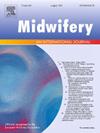妊娠期高血压或轻度子痫前期妇女引产的分娩特征和母婴结局
IF 2.5
3区 医学
Q1 NURSING
引用次数: 0
摘要
背景:探讨妊娠期高血压疾病(HDP)孕妇引产(IOL)的分娩特点及相关的母婴结局,并探讨引产失败的危险因素。材料与方法本队列研究纳入425例接受人工晶状体植入术的孕妇,将她们分为两组:HDP组和正常妊娠组。比较引产特点、干预措施及母婴结局。通过单因素分析和logistic回归分析确定人工晶状体失败的危险因素。结果与对照组相比,HDP组的剖宫产率(CS)明显高于对照组,且HDP组新生儿转入新生儿重症监护病房(P <;0.05)。除了HDP组会阴中外侧切开术的发生率较高外,两组成功人工晶状体植入的产妇在分娩时间和产时干预方面差异不大。奇偶性(OR 0.201;95% CI 0.053 ~ 0.763), bishop评分(OR 0.658;95% CI 0.512 ~ 0.845),出生体重(OR 1.001;95% CI 1.000 ~ 1.002),妊娠期高血压疾病(HDP) (OR 2.502;95% CI 1.374 - 4.559)被确定为与人工晶状体失败风险增加相关的因素。结论HDP患者人工晶状体植入术后CS发生率和会阴中外侧切开术风险均高于正常妊娠患者,而引产特点、多数产时干预措施及母婴结局相似。本文章由计算机程序翻译,如有差异,请以英文原文为准。
Labor characteristics and maternal and neonatal outcomes in women with gestational hypertension or mild preeclampsia who underwent labor induction
Background
To investigate the labor characteristics and maternal-neonatal outcomes associated with induction of labour (IOL) in pregnant women with hypertensive disorders of pregnancy (HDP), as well as to identify the risk factors for the failed induction of labor.
Material and methods
This cohort study enrolled 425 pregnant women who underwent IOL, and they were divided into two groups: the HDP group and the normotensive pregnancies group. Labor induction characteristics, interventions and maternal and neonatal outcomes were compared. Univariate analysis and logistic regression analysis were conducted to identify the risk factors for the failed IOL.
Results
Compared to the control group, the HDP group exhibited a significantly higher rate of cesarean section (CS), and newborns in the HDP group were more likely to be transferred to the neonatal intensive care unit (P < 0.05). There was little difference in labor durations and intrapartum interventions between the two groups of women with successful IOL, except for a higher rate of mediolateral episiotomy in the HDP group. Parity (OR 0.201; 95 % CI 0.053 to 0.763), bishop score (OR 0.658; 95 % CI 0.512 to 0.845), birth weight (OR 1.001; 95 % CI 1.000 to 1.002), and hypertensive disorders of pregnancy (HDP) (OR 2.502; 95 % CI 1.374 to 4.559) were identified as factors associated with an increased risk of failed IOL.
Conclusions
Women with HDP exhibited an increased risk of CS rate and mediolateral episiotomy after IOL compared to those with normotensive pregnancies, while the characteristics of induced labor, most intrapartum interventions and maternal and neonatal outcomes were similar.
求助全文
通过发布文献求助,成功后即可免费获取论文全文。
去求助
来源期刊

Midwifery
医学-护理
CiteScore
4.50
自引率
7.40%
发文量
221
审稿时长
13.4 weeks
期刊介绍:
Midwifery publishes the latest peer reviewed international research to inform the safety, quality, outcomes and experiences of pregnancy, birth and maternity care for childbearing women, their babies and families. The journal’s publications support midwives and maternity care providers to explore and develop their knowledge, skills and attitudes informed by best available evidence.
Midwifery provides an international, interdisciplinary forum for the publication, dissemination and discussion of advances in evidence, controversies and current research, and promotes continuing education through publication of systematic and other scholarly reviews and updates. Midwifery articles cover the cultural, clinical, psycho-social, sociological, epidemiological, education, managerial, workforce, organizational and technological areas of practice in preconception, maternal and infant care.
The journal welcomes the highest quality scholarly research that employs rigorous methodology. Midwifery is a leading international journal in midwifery and maternal health with a current impact factor of 1.861 (© Thomson Reuters Journal Citation Reports 2016) and employs a double-blind peer review process.
 求助内容:
求助内容: 应助结果提醒方式:
应助结果提醒方式:


